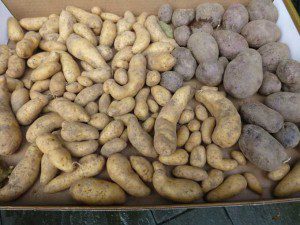Just thought I’d share a picture of this year’s potato harvest. Nothing spectacular about it until you consider that I didn’t plant a single potato this season. All these potatoes are the result of volunteer plants that sprouted on their own and received no special care or attention this summer.
I didn’t even notice the unplanned potato patch until long after that section of the garden had been planted with an assortment of leafy greens that included kale, lettuces, and mustards. My first thought was to simply pull up the potato vines once I noticed them popping up in the midst of the other vegetables, but now I’m glad I didn’t follow through with that thought.
Volunteered or Fall Planted Potatoes in the Garden
 A volunteer potato vine or two frequently appear in the springtime but never as many as there were this year. Not sure whether this was due to the mild winter or a hasty previous harvest that left more overlooked spuds underground in the garden the previous summer. I have come across gardeners who make a habit of fall planting their seed potatoes, but I’ve never tried that practice intentionally myself.
A volunteer potato vine or two frequently appear in the springtime but never as many as there were this year. Not sure whether this was due to the mild winter or a hasty previous harvest that left more overlooked spuds underground in the garden the previous summer. I have come across gardeners who make a habit of fall planting their seed potatoes, but I’ve never tried that practice intentionally myself.
It wasn’t so much a surprise that the seed crop survived the winter underground, but I didn’t expect the plants to make it through the summer and be so productive with absolutely no attention on my part. No weeding, no hilling, no watering, and no feeding was offered. And there was not a single sign of a potato bug, flea beetle, or other pest creating havoc on the vines.
I’ll have to check my records to see exactly which varieties were planted out during the previous year and regrew this season. I know that one is a fingerling style and the other is a blue-fleshed variety. I’ve become even more interested in cultivating blue potatoes after watching a recent video clip that described some of their nutritional advantages.
Raising a Care-Free, Low Maintenance, Potato Crop
So what was it that made life so care-free for these lucky spuds? Was it that they were able to set their own timetable and begin growing exactly when they felt that the weather was right? Maybe the greens were a perfect companion crop that helped keep weeds at bay and shaded the soil to conserve moisture.
This has been a very good year for bugs… in the sense that there just haven’t been many destructive ones spotted in the garden. I have been on a quest to eliminate the use of ALL pest control sprays, even the organic ones, and have been trying to let nature itself manage the insect populations. Maybe having the potato vines grow up scattered in the midst of other crops helped to avoid attracting insect pests.
There were also fewer potato plants in total than I normally would have when planting a potato patch in the garden. Maybe that could have made it more difficult, or just not worth the effort for potato bugs to bother with. Despite the limited number of plants, the harvest was very good from this little group of volunteers.
I’ll chalk this one up as an unexpected success and may experiment with planting a few tubers this fall in some of the perennial sections of the garden to see if I can duplicate the results again. In the meantime I think a few of those freshly dug fingerling potatoes will cook up nicely with some tasty leaves of lacinato kale that have been calling me to come and harvest them too!


 Address:
Address: EMAIL:
EMAIL: Telephone:
Telephone: